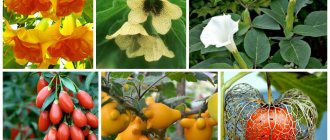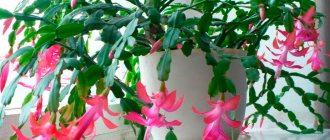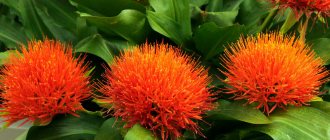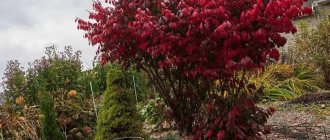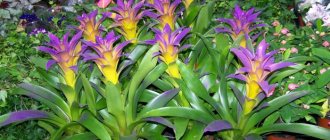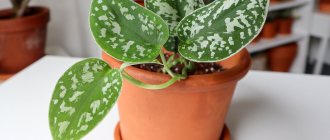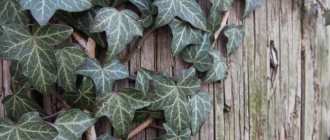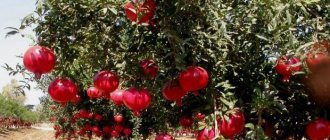Japanese euonymus (Euonymus japonica) is a fast-growing, evergreen shrub with leathery leaves. Depending on the variety, the leaf blades may be green, with a white or golden edge.
The flowers are small, white-green, collected in umbrella-shaped inflorescences, and have no decorative value. The flowering period occurs in mid-summer. Only mature plants can bloom, and then quite rarely. The fruits are four-lobed capsules. In indoor conditions, the height of the plant does not exceed 1 meter; in nature it can reach up to 6 meters or more. It has a high life expectancy, requiring annual pruning and periodic rejuvenation. Has a pronounced rest period.
| Growing quickly. In one season, the plant gains 10-20 cm in height. |
| It blooms very rarely and only on mature individuals. |
| The plant is easy to grow. |
| Perennial. Rejuvenate every 3-4 years. |
Caring for euonymus at home. Briefly
Euonymus at home requires the following care:
| Temperature | In summer +18-20°C, in winter +2-4°C. |
| Air humidity | Dense leaves easily withstand dry air. But when the heating is turned on, spraying may be required. |
| Lighting | Bright diffused light, without direct sunlight. |
| Watering | As the earthen coma dries out. Limited in winter. |
| Priming | A mixture of turf soil with humus with the addition of sand or perlite. |
| Feeding and fertilizer | During the period of intensive growth, once every 3-4 weeks, apply any complex fertilizer for decorative foliage plants. |
| Euonymus transplant | As you grow. Usually once a year. |
| Reproduction | Propagated by cuttings of green and semi-lignified shoots. For rooting, use light peat soil or clean sand. |
| Features of growing euonymus. | In winter, the plant needs to create a dormant period at low temperatures. To maintain its shape, it requires pruning in the spring. |
Botanical description
It is an evergreen ornamental perennial plant characterized by variegated leaves and brightly colored fruits. Genus - Euonymus. Family - Euonymus. In nature, there are representatives up to 7-8 m high. In garden conditions, due to regular pruning, small shrub varieties are grown within 1-1.5 m, and the formed spherical tree on a trunk stretches up to 3-4 m. Commonly used as an indoor ornamental plant . It has 2 growth periods - spring and autumn. At the end of each of them, large buds form on the tops of fresh shoots. The annual growth is about 20 cm.
The second name is pseudolaurus (similar to laurel with its glossy elongated leaves). In Latin it sounds like Euonymus japonicus.
Leaves:
- leathery, fleshy, dense, smooth, glossy;
- short petioles;
- jagged edges;
- oval-elongated shape;
- in length - 3-8 cm.
Flowers:
- small (diameter - 1 cm);
- light green with a yellowish tint, lost against the background of bright foliage;
- inflorescences - an umbrella in which about 100 flowers can be collected;
- Flowering period is July.
Fruit:
- unusual in appearance, shape, color, which gives additional decorative properties to the shrub;
- orange-pinkish with white protruding pads, on which black seeds are visible (diameter - 0.8 cm);
- spherical;
- ripen in September and remain on the branches until the end of October.
It grows under natural conditions in the Far East, Japan, China, and Korea. It was brought to Europe as an ornamental shrub in the 19th century and has since been actively used in home floriculture and landscape design.
Attention! Many people are interested in whether Japanese euonymus is poisonous or not. Yes, all parts and even the juice contain toxins that are dangerous to the human body if ingested. Therefore, eating fruits and working with them without gloves (especially when pruning) is strictly prohibited.
Caring for euonymus at home. Details
Like any other indoor plant, home euonymus requires some care. It can grow and bloom fully only if suitable conditions are created.
Euonymus flowering
The euonymus flower blooms extremely rarely at home .
To set flower buds, it needs a cold period of at least 2 months. You can create the necessary conditions on a frost-free loggia or veranda. The main thing is that the temperature does not rise above +10° and does not fall below +2°. The flowering of Japanese euonymus can also be stimulated by applying phosphorus-potassium fertilizers during the period of intensive growth. The plant cannot be fed when it is dormant.
Temperature
Euonymus at home requires maintaining moderate temperatures. The plant can react to a sharp drop by dropping leaves. It grows best at temperatures from +22 to +25°C.
In winter, Japanese euonymus should be placed on cool windows, away from heating radiators.
Spraying
When caring for euonymus at home, you should remember the need for spraying. It is especially important on hot summer days and during the heating season. For spraying, use settled water at room temperature. Otherwise, limescale will constantly form on the leaves.
It is useful to alternate spraying with a warm shower. It will not only clean the surface of the leaves from contamination, but also prevent the appearance of pests.
Lighting
For successful development, euonymus requires bright but diffuse lighting. It feels best on windows of eastern and western orientation. When placed on the south side it will have to be shaded. With a lack of lighting, the brightness of the color of the leaves is lost, they gradually begin to turn yellow and disappear.
Watering
During periods of intensive growth, euonymus requires abundant watering. At the same time, the soil substrate must not be allowed to become acidic, which can lead to the death of the plant.
It is optimal if the top layer of soil dries out a little between waterings. During cold wintering, watering is sharply limited. Watering is carried out only after the soil has completely dried.
Euonymus pot
Plastic and clay pots are suitable for growing euonymus. The main thing is that their size matches the size of the root system.
Transplanting from a small to a too large container is fraught with acidification of the soil and the death of the plant.
Soil for euonymus
Euonymus does not have any special requirements for soil. A sufficiently nutritious, loose substrate is suitable for its cultivation. For example, you can use soil made up of equal parts of humus, peat and sand with the addition of 2 parts of turf soil.
You can also purchase a ready-made industrial substrate for growing decorative leafy indoor plants.
Top dressing
Japanese euonymus is fed only during the period of intensive growth. To do this, use a complex organic-mineral fertilizer for decorative deciduous plants.
It should be diluted in full accordance with the attached instructions.
Fertilizing is applied once a week. Fertilizers are not used during the dormant period.
Euonymus transplant
Young euonymus plants require annual replanting.
Adult specimens are transshipped as needed. To do this, they are carefully shaken out of the old pot. Then carefully examine the root system. All old and rotten areas of roots are cut out using a sharp knife or scissors. When replanting, be sure to create a drainage layer at the bottom of the pot and check for holes to drain excess water.
Trimming
Euonymus pruning is carried out in early spring. Its goal is to obtain a thicker crown. To do this, remove the tops of elongated shoots. After this, 2-3 new shoots grow at the cut site. During pruning, the plant can also be given different shapes.
Use in landscape design
In the garden, Japanese euonymus can serve not only as decoration, but also become a full-fledged hedge. When the bush reaches a good height and density, it makes a wonderful topiary. This is the name of a shrub sculpture, which is created by cutting a plant to shape. In the garden you can create your own “living” pyramid, animal and any other figure.
Real masters can create a “living” labyrinth from a series of bushes through which you can walk. In Japan, euonymus is used for growing bonsai, and in Europe for creating topiaries. Both of these concepts relate to gardening art.
Euonymus propagation
Euonymus can be propagated by both seed and vegetative methods.
Propagation of euonymus by cuttings
For cuttings, young, non-lignified shoots up to 5 cm long are cut from the plant. Before planting, it is recommended to treat them with a root formation stimulator. For example, you can use “Kornevin” or “Heteroauxin”.
For planting cuttings, a two-layer substrate is used. Its lower layer is made up of clean river sand, the upper layer is made of fertile, loose soil. The rooting process can last up to 1.5 months. After the plants begin to grow, they need to be pinched.
Growing euonymus from seeds
In summer, seed propagation can also be used. Since euonymus seeds are difficult to germinate before planting, they must be stratified at a temperature of 0 to +2°C for 2-3 months.
The readiness of the seeds for planting is determined by cracking of the skin. After this, they must be cleaned of any remaining covering peel and pickled in a weak solution of potassium permanganate. For sowing, loose, moisture-absorbing soil is used. As soon as the seedlings reach a height of 3-4 cm, they are dived into separate containers.
Diseases and pests
When growing euonymus, a number of problems may arise:
- Euonymus shoots stretch out. This problem occurs when there is insufficient lighting.
- The leaves are fading. With too much sunlight, the leaf blades become dull.
- The edges of the euonymus leaves are folded. Observed when placing the plant in the sun.
- The leaves turn yellow and fall off when the plant is flooded. Without taking appropriate measures in the future, it dies.
- Euonymus does not grow with excessive watering and constant stagnation of moisture.
The most common pests that attack euonymus are spider mites, scale insects, mealybugs and aphids. To combat them, it is recommended to use systemic insecticides.
Cultivation
Due to its excellent decorative properties, unpretentiousness and ease of care, increased survival in polluted air, Japanese euonymus is actively cultivated. Widely used in landscape design of cities and private areas. The most common options:
- landscaping of city parks and squares;
- hedge;
- curbs;
- garden figures;
- alpine slides;
- Japanese garden;
- flower beds of continuous flowering;
- decoration of gazebos.
Most often, flowerpots and small pots with Japanese euonymus are displayed on the site, without transplanting into open ground. This makes it easier to remove the plant for the winter.
Popular varieties of Japanese indoor euonymus with names and photos
In indoor floriculture, the following varieties of euonymus are most often used:
Latifolius Albomarginatus
Characterized by dark green leaf blades with a wide light border.
Luna
Greenish-yellow leaves with green edges.
Albomarginatus
Rich green leaves with a narrow white edge.
Mediopictus
The middle of the leaf blades is yellow, the edges are green.

